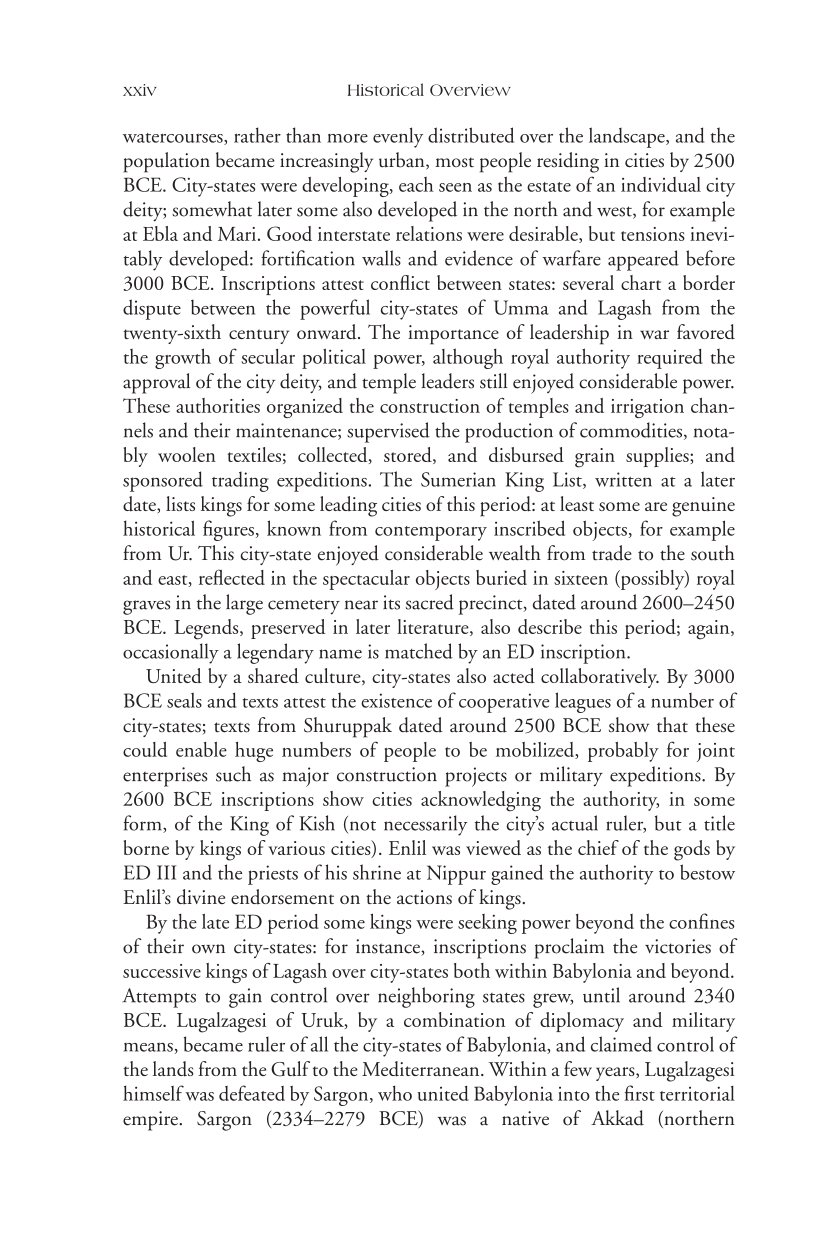xxiv Historical Overview
watercourses, rather than more evenly distributed over the landscape, and the
population became increasingly urban, most people residing in cities by 2500
BCE. City-states were developing, each seen as the estate of an individual city
deity; somewhat later some also developed in the north and west, for example
at Ebla and Mari. Good interstate relations were desirable, but tensions inevi-
tably developed: fortification walls and evidence of warfare appeared before
3000 BCE. Inscriptions attest conflict between states: several chart a border
dispute between the powerful city-states of Umma and Lagash from the
twenty-sixth century onward. The importance of leadership in war favored
the growth of secular political power, although royal authority required the
approval of the city deity, and temple leaders still enjoyed considerable power.
These authorities organized the construction of temples and irrigation chan-
nels and their maintenance; supervised the production of commodities, nota-
bly woolen textiles; collected, stored, and disbursed grain supplies; and
sponsored trading expeditions. The Sumerian King List, written at a later
date, lists kings for some leading cities of this period: at least some are genuine
historical figures, known from contemporary inscribed objects, for example
from Ur. This city-state enjoyed considerable wealth from trade to the south
and east, reflected in the spectacular objects buried in sixteen (possibly) royal
graves in the large cemetery near its sacred precinct, dated around 2600–2450
BCE. Legends, preserved in later literature, also describe this period; again,
occasionally a legendary name is matched by an ED inscription.
United by a shared culture, city-states also acted collaboratively. By 3000
BCE seals and texts attest the existence of cooperative leagues of a number of
city-states; texts from Shuruppak dated around 2500 BCE show that these
could enable huge numbers of people to be mobilized, probably for joint
enterprises such as major construction projects or military expeditions. By
2600 BCE inscriptions show cities acknowledging the authority, in some
form, of the King of Kish (not necessarily the city’s actual ruler, but a title
borne by kings of various cities). Enlil was viewed as the chief of the gods by
ED III and the priests of his shrine at Nippur gained the authority to bestow
Enlil’s divine endorsement on the actions of kings.
By the late ED period some kings were seeking power beyond the confines
of their own city-states: for instance, inscriptions proclaim the victories of
successive kings of Lagash over city-states both within Babylonia and beyond.
Attempts to gain control over neighboring states grew, until around 2340
BCE. Lugalzagesi of Uruk, by a combination of diplomacy and military
means, became ruler of all the city-states of Babylonia, and claimed control of
the lands from the Gulf to the Mediterranean. Within a few years, Lugalzagesi
himself was defeated by Sargon, who united Babylonia into the first territorial
empire. Sargon (2334–2279 BCE) was a native of Akkad (northern





























































































































































































































































































